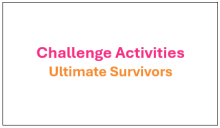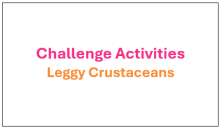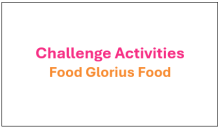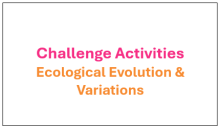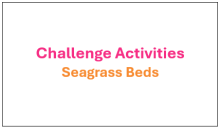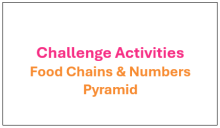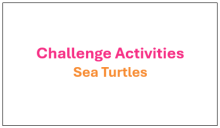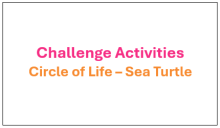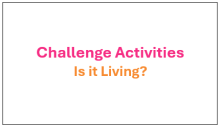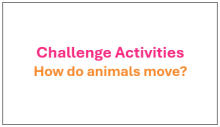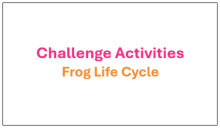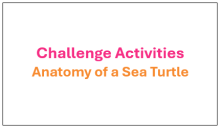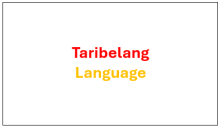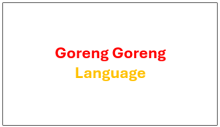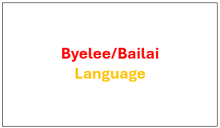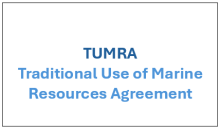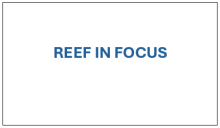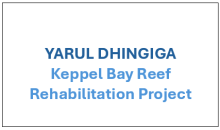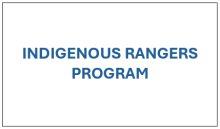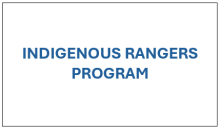- All pages
- Primary school
- Middle school
- Senior school
Primary Grade 5 - Ultimate Survivor
Adaptations
1. Design the ultimate reef creature animal species name.
2. Draw your creature!
a) Would an animal with a shark's body, jellyfish tentacles and stonefish camouflage be the ultimate survivor on a coral reef?
b) Using what you already know, and the information on page 2, create your own Ultimate Reef Creature. Make sure to name your creation and list it’s adaptations in the boxes below, then draw what your creature would look like.
c) Pick your favourite reef creature and tick the adaptations they possess from the list below.
Primary Grade 5 -Leggy Crustaceans
Adaptations
Crustaceans have adapted their jointed, armoured legs so that they can be used not just for walking over sand and coral, but for swimming, feeling, catching and grasping food, holding bunches of eggs and even for shooting backwards.
1. Using the letters in this table, colour in the legs as indicated and find out uses of the different legs on each of these crustaceans. Some legs may be used for more than one action.
Primary Grade 5 - Food Glorius Food
Adaptations
1. Use the information on page 2 to help you complete the table below as you explore animal shapes, habitats and special features. Explore animal shapes, habitats and special features.
An animal’s mouth and body shape, as well as the habitat it lives in can give us clues as to what it feeds upon. Many marine organisms also possess defence mechanisms to prevent them from becoming food themselves.
2. Use the information below to assist you in completing the table on the previous page.
Primary Grade 5 - Ecological Evolution & Variations
Adaptations
1. How do corals compete for light? Reef building corals require solar energy to grow and lay down their skeleton.
2. Your challenge is to investigate the structural adaptations that corals have evolved to compete for this valuable resource.
3. Use the information gained to complete the table below.
Primary Grade 4 - Seagrass Beds
Seagrass meadows are important ecosystems in the Great Barrier Reef Marine Park.
Colour all the animals you can find and then answer the following questions.
1. Identify as many organisms as you can and record their names below:
2. Define the following terms: a. Producer b. Consumer c. Decomposer
3. Identify an organism in a seagrass meadow that is a: a. Producer b. Consumer c. Decomposer
Primary Grade 4 - Food Chains & Numbers Pyramid
1. Consider the following levels in a food chain. Write examples of the plants or animals that represent each level in a marine food chain environment.
2. Food chains vary in length though are rarely more than five levels. Suggest a reason for this.
3. Food webs give a useful description of the feeding relationships in an ecosystem.
a. Using the examples you have written in the table above, draw a pyramid of numbers which represents this food chain.
b. Draw a pyramid of numbers that represents the following scenario: a large predatory fish covered in parasites, being cleaned by a symbiotic cleaner fish.
Pagination
Primary Grade 3 - Turtle Life Cycle
Find the missing word in the text below.
Primary Grade 3 - Turtle Life Cycle
Cut out the front and back wheels below and colour the pictures. Attach the front to the back with a paper fastener. Spin the wheel in the direction of the arrow to follow the life cycle of a turtle.
Primary Grade 3 - Is it Living?
One of the first things Scientists do when classifying something for the first time is to decide if it is alive. There are 8 characteristics to check if something is alive.
Decide if the following items in the columns meet the requirements to be classified as a living thing (tick the box if the item meets the requirement).
Primary Grade 3 - How do animals move?
Marine creatures move in different ways.
Research the following animals to find out what structure(s) of the animal is used to move.
Primary Grade 3 - Frog Life Cycle
Cut out the seven stages of the frog life cycle and paste them into their correct spot in the diagram.
Primary/Middle Grade 2-7
Use the words in the box below to label the parts of the Sea Turtle.
Pagination
ACTIVITY Chatterbox - Taribelang Language
Unlock the secrets of learning with our Chatterbox Challenge – where every fold leads to new knowledge!
Taribelang, also known as Bunda, Gureng-Gureng is a language of Queensland. Although no longer spoken as a native language by the Taribelang or Bunda people, it is spoken as a 2nd or 3rd language by under 100.
ACTIVITY Chatterbox - Goreng Goreng Language
Unlock the secrets of learning with our Chatterbox Challenge – where every fold leads to new knowledge!
The Gurang Gurang and Goreng Goreng languages are closely related but not the same. Both languages belong to the Waka-Kabic subgroup of the Pama–Nyungan languages.
The names are often used interchangeably, and there is some overlap in the regions where they are spoken, primarily in Central Queensland.
The differences between them are subtle and often pertain to dialectal variations rather than being entirely separate languages. For example, the pronunciation and some vocabulary might differ slightly between the two!
ACTIVITY Chatterbox - Byellee/Bailai Language
Unlock the secrets of learning with our Chatterbox Challenge – where every fold leads to new knowledge!
Bayali (also spelt Biyali, Baiali, Byelle, Byellee, and also known as Orambul or Urambal) is an extinct Australian Aboriginal language of Queensland in Australia, spoken in the Rockhampton and Gladstone areas.
VIDEO - Working with Traditional Owners for Sea Country Management across GBRMPA
Jason discusses tools to provide genuine pathways for Traditional Owner groups to engage in effective co-management of the Great Barrier Reef Marine Parks, both Commonwealth and State, and the Great Barrier Reef World Heritage Area.
This includes Traditional Use of Marine Resources Agreements (TUMRAs) as one tool that describes how Traditional Owners work in partnership with the Australian and Queensland governments to manage traditional use activities on their Sea Country.
Jason’s key message is that maintaining effective and meaningful partnerships with Traditional Owners is essential in protecting cultural and heritage values, conserving biodiversity and enhancing the resilience of the Great Barrier Reef into the future.
VIDEO - Reef in Focus: Managing Sea Country Webinar
In honor of National Reconciliation Week 2022, the Reef Authority held a Reef in Focus webinar, 'Managing Sea Country' on Tuesday 31 May 2022. Learn first-hand from our First Nations partners about their deep connection to the Great Barrier Reef and their expanding role in its management.
VIDEO - Yarul Dhingiga: Keppel Bay Reef Rehabilitation Project
In October 2022, the Reef Joint Field Management Program, the Woppaburra TUMRA Aboriginal Corporation (WTAC) and local tourism operators came together on Woppaburra Country for the third trial of the MARRS (Mars Assisted Reef Restoration System) reef star – hexagonal metal frames that can be placed on the seabed, in areas of loose coral rubble, to provide a stable platform for live coral fragment attachment.
Pagination
ACTIVITY Chatterbox - Byellee/Bailai Language
Unlock the secrets of learning with our Chatterbox Challenge – where every fold leads to new knowledge!
Bayali (also spelt Biyali, Baiali, Byelle, Byellee, and also known as Orambul or Urambal) is an extinct Australian Aboriginal language of Queensland in Australia, spoken in the Rockhampton and Gladstone areas.
VIDEO - Working with Traditional Owners for Sea Country Management across GBRMPA
Jason discusses tools to provide genuine pathways for Traditional Owner groups to engage in effective co-management of the Great Barrier Reef Marine Parks, both Commonwealth and State, and the Great Barrier Reef World Heritage Area.
This includes Traditional Use of Marine Resources Agreements (TUMRAs) as one tool that describes how Traditional Owners work in partnership with the Australian and Queensland governments to manage traditional use activities on their Sea Country.
Jason’s key message is that maintaining effective and meaningful partnerships with Traditional Owners is essential in protecting cultural and heritage values, conserving biodiversity and enhancing the resilience of the Great Barrier Reef into the future.
VIDEO - Reef in Focus: Managing Sea Country Webinar
In honor of National Reconciliation Week 2022, the Reef Authority held a Reef in Focus webinar, 'Managing Sea Country' on Tuesday 31 May 2022. Learn first-hand from our First Nations partners about their deep connection to the Great Barrier Reef and their expanding role in its management.
VIDEO - Yarul Dhingiga: Keppel Bay Reef Rehabilitation Project
In October 2022, the Reef Joint Field Management Program, the Woppaburra TUMRA Aboriginal Corporation (WTAC) and local tourism operators came together on Woppaburra Country for the third trial of the MARRS (Mars Assisted Reef Restoration System) reef star – hexagonal metal frames that can be placed on the seabed, in areas of loose coral rubble, to provide a stable platform for live coral fragment attachment.
VIDEO - Indigenous Ranger Training on the Reef
We recently brought together a number of Indigenous ranger groups from across the Great Barrier Reef to complete incident management training. Aboriginal and Torres Strait Islander people are the Traditional Owners of the Great Barrier Reef region, and evidence of their sea country connections goes back over 60,000 years.
VIDEO - Indigenous Rangers on the Reef
The Indigenous ranger's program is a nationally accredited training course by the Great Barrier Reef Marine Park Authority. It provides rangers with the skills to ensure Marine Park users comply with its rules and traditional lore.
The Authority understands that having an effective and meaningful partnership with Traditional Owners is essential to protect cultural and heritage values, conserve biodiversity and enhance the resilience of the Reef.

